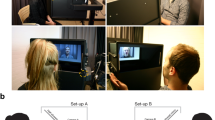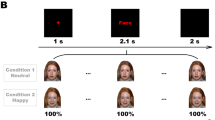Abstract
To investigate the role of the prefrontal cortex (PFC) in processing multimodal communicative ostensive signals in infants, we measured cerebral hemodynamic responses by using near-infrared spectroscopy (NIRS) during the social interactive play “peek-a-boo”, in which both visual (direct gaze) and auditory (infant-directed speech) stimuli were presented. The infants (mean age, around 7 months) sat on their mother’s lap, equipped with an NIRS head cap, and looked at a partner’s face during “peek-a-boo”. An eye-tracking system simultaneously monitored the infants’ visual fixation patterns. The results indicate that, when the partner presented a direct gaze, rather than an averted gaze, toward an infant during social play, the infant fixated on the partner’s eye region for a longer duration. Furthermore, hemodynamic activity increased more prominently dorsomedial prefrontal cortex (mPFC) in response to social play with a partner’s direct gaze compared to an averted gaze. In contrast, hemodynamic activity increased in the right dorsolateral prefrontal cortex (R-lPFC) regardless of a partner’s eye gaze direction. These results indicate that a partner’s direct gaze shifts an infant’s attention to the partner’s eyes for interactive communication, and specifically activates the mPFC. The differences in hemodynamic responses between the mPFC and R-lPFC suggest functional differentiation within the PFC, and a specific role of the mPFC in the perception of face-to-face communication, especially in mutual gaze, which is essential for social interaction.






Similar content being viewed by others
References
Allison T, Puce A, McCarthy G (2000) Social perception from visual cues: role of the STS region. Trends Cogn Sci 4:267–278
Amodio DM, Frith CD (2006) Meeting of minds: the medial frontal cortex and social cognition. Nat Rev Neurosci 7:268–277
Baron-Cohen S (1995) Mind blindness: an essay on autism and theory of mind. The MIT Press, London
Bhatt S, Mbwana J, Adeyemo A, Sawyer A, Hailu A, Vanmeter J (2009) Lying about facial recognition: an fMRI study. Brain Cogn 69:382–390
Bryson SE, Zwaigenbaum L, Roberts W (2004) The early detection of autism in clinical practice. Paediatr Child Health 9:219–221
Cristia A, Dupoux E, Hakuno Y, Lloyd-Fox S, Schuetze M, Kivits J, Bergvelt T, van Gelder M, Filippin L, Charron S, Minagawa-Kawai Y (2013) An online database of infant functional near infrared spectroscopy studies: a community-augmented systematic review. PLoS One 83:e58906
Csibra G, Gergely G (2006) Social learning and social cognition: the case for pedagogy. In: Munakata Y, Johnson MH (eds) Processes of change in brain and cognitive development. Attention and performance XXI. Oxford University Press, New York, pp 249–274
Csibra G, Henty J, Volein A, Elwell C, Tucker L, Meek J, Johnson MH (2004) Near infrared spectroscopy reveals neural activation during face perception in infants and adults. J Pediatr Neurol 2:85–89
Druzgal TJ, D’Esposito M (2001) A neural network reflecting decisions about human faces. Neuron 32:947–955
Elsabbagh M, Bedford R, Senju A, Charman T, Pickles A, Johnson MH; The BASIS Team (2014) What you see is what you get: contextual modulation of face scanning in typical and atypical development. Soc Cogn Affect Neurosci 9:538–543
Farroni T, Csibra G, Simion F, Johnson MH (2002) Eye contact detection in humans from birth. Proc Natl Acad Sci USA 99:9602–9605
Gilbert SJ, Williamson ID, Dumontheil I, Simons JS, Frith CD, Burgess PW (2007) Distinct regions of medial rostral prefrontal cortex supporting social and nonsocial functions. Soc Cog Affect Neurosci 2:217–226
Goren CC, Sarty M, Wu PYK (1975) Visual following and pattern discrimination of face-like stimuli by newborn infants. Pediatrics 56:544–549
Greenfield PM (1972) Playing peekaboo with a four-month-old: a study of the role of speech and nonspeech sounds in the formation of a visual schema. J Psychol 82:287–298
Grossmann T (2013a) The role of medial prefrontal cortex in early social cognition. Front Hum Neurosci 7:340
Grossmann T (2013b) Mapping prefrontal cortex functions in human infancy. Infancy 18:303–324
Grossmann T, Johnson MH (2010) Selective prefrontal cortex responses to joint attention in early infancy. Biol Lett 6:540–543
Grossmann T, Johnson MH, Farroni T, Csibra G (2007) Social perception in the infant brain: gamma oscillatory activity in response to eye gaze. Soc Cogn Affect Neurosci 2:284–291
Grossmann T, Johnson MH, Lloyd-Fox S, Blasi A, Deligianni F, Elwell C, Csibra G (2008) Early cortical specialization for face-to-face communication in human infants. Proc Biol Sci 275:2803–2811
Grossmann T, Parise E, Friederici AD (2010) The detection of communicative signals directed at the self in infant prefrontal cortex. Front Hum Neurosci 4:1–5
Grossmann T, Lloyd-Fox S, Johnson MH (2013) Brain responses reveal young infants’ sensitivity to when a social partner follows their gaze. Dev Cogn Neurosci 6:155–161
Hains SM, Muir DW (1996) Infant sensitivity to adult eye direction. Child Dev 67:1940–1951
Hoshi Y, Kobayashi N, Tamura M (2001) Interpretation of near-infrared spectroscopy signals: a study with a newly developed perfused rat brain model. J Appl Physiol 90:1657–1662
Jasper HH (1958) The ten-twenty electrode system of the International Federation. Electroencephalogr Clin Neurophysiol 10:371–375
Johnson MH, Dziurawiec S, Ellis H, Morton J (1991) Newborns’ preferential tracking of face-like stimuli and its subsequent decline. Cognition 40:1–19
Kampe KK, Frith CD, Frith U (2003) “Hey John”: signals conveying communicative intention toward the self activate brain regions associated with “mentalizing”, regardless of modality. J Neurosci 23:5258–5263
Kanwisher N, McDermott J, Chun MM (1997) The fusiform face area: a module in human extrastriate cortex specialized for face perception. J Neurosci 17:4302–4311
Kleinke CL (1986) Gaze and eye contact: a research review. Psychol Bull 100:78–100
Kuzmanovic B, Georgescu AL, Eickhoff SB, Shah NJ, Bente G, Fink GR, Vogeley K (2009) Duration matters: dissociating neural correlates of detection and evaluation of social gaze. Neuroimage 46:1154–1163
Lloyd-Fox S, Blasi A, Volein A, Everdell N, Elwell CE, Johnson MH (2009) Social perception in infancy: a near infrared spectroscopy study. Child Dev 80:986–999
Lloyd-Fox S, Blasi A, Everdell N, Elwell CE, Johnson MH (2011) Selective cortical mapping of biological motion processing in young infants. J Cogn Neurosci 23:2521–2532
Lloyd-Fox S, Blasi A, Elwell CE, Charman T, Murphy D, Johnson MH (2013) Reduced neural sensitivity to social stimuli in infants at risk for autism. Proc Biol Sci 280:20123026
Meek JH, Firbank M, Elwell CE, Atkinson J, Braddick O, Wyatt JS (1998) Regional hemodynamic responses to visual stimulation in awake infants. Pediatr Res 43:840–843
Minagawa-Kawai Y, Matsuoka S, Dan I, Naoi N, Nakamura K, Kojima S (2009) Prefrontal activation associated with social attachment: facial-emotion recognition in mothers and infants. Cereb Cortex 19:284–292
Montague DP, Walker-Andrews AS (2001) Peekaboo: a new look at infants’ perception of emotion expressions. Dev Psychol 37:826–828
Nakato E, Otsuka Y, Kanazawa S, Yamaguchi MK, Watanabe S, Kakigi R (2009) When do infants differentiate profile face from frontal face? A near-infrared spectroscopic study. Hum Brain Mapp 30:462–472
Nakato E, Otsuka Y, Kanazawa S, Yamaguchi MK, Honda Y, Kakigi R (2011) I know this face: neural activity during mother’s face perception in 7- to 8-month-old infants as investigated by near-infrared spectroscopy. Early Hum Dev 87:1–7
Opitz B, Mecklinger A, Friederici AD (2000) Functional asymmetry of human prefrontal cortex: encoding and retrieval of verbally and nonverbally coded information. Learn Mem 7(2):85–96
Otsuka Y, Nakato E, Kanazawa S, Yamaguchi MK, Watanabe S, Kakigi R (2007) Neural activation to upright and inverted faces in infants measured by near infrared spectroscopy. Neuroimage 34:399–406
Parise E, Csibra G (2013) Neural responses to multimodal ostensive signals in 5-month-old infants. PLoS One 8:72360
Phillips W, Baron-Cohen S, Rutter M (1992) The role of eye-contact in the detection of goals: evidence from normal toddlers, and children with autism or mental handicap. Dev Psychopathol 4:375–383
Puce A, Allison T, Asgari M, Gore JC, McCarthy G (1996) Differential sensitivity of human visual cortex to faces, letterstrings, and textures: a functional magnetic resonance imaging study. J Neurosci 16:5205–5215
Reid VM, Striano T (2005) Adult gaze influences infant attention and object processing: implications for cognitive neuroscience. Eur J Neurosci 21:1763–1766
Schilbach L, Wohlschlaeger AM, Kraemer NC, Newen A, Shah NJ, Fink GR, Vogeley K (2006) Being with virtual others: neural correlates of social interaction. Neuropsychologia 44:718–730
Schroeter ML, Zysset S, Kruggel F, von Cramon DY (2003) Age dependency of the hemodynamic response as measured by functional near-infrared spectroscopy. Neuroimage 19:555–564
Senju A, Csibra G (2008) Gaze following in human infants depends on communicative signals. Curr Biol 18:668–671
Stoyanova RS, Ewbank MP, Calder AJ (2010) “You talkin’ to me?” Self-relevant auditory signals influence perception of gaze direction. Psychol Sci 21:1765–1769
Strangman G, Culver JP, Thompson JH, Boas DA (2002) A quantitative comparison of simultaneous BOLD fMRI and NIRS recordings during functional brain activation. NeuroImage 17:719–731
Strouse GA, Troseth GL (2008) “Don’t try this at home”: toddlers’ imitation of new skills from people on video. J Exp Child Psychol 101:262–280
Taga G, Homae F, Watanabe H (2007) Effects of source-detector distance of near infrared spectroscopy on the measurement of the cortical hemodynamic response in infants. NeuroImage 38:452–460
Takamoto K, Hori E, Urakawa S, Katayama M, Nagashima Y, Yada Y, Ono T, Nishijo H (2013) Thermotherapy to the facial region in and around the eyelids altered prefrontal hemodynamic responses and autonomic nervous activity during mental arithmetic. Psychophysiology 50:35–47
Takeuchi M, Hori E, Takamoto K, Tran AH, Satoru K, Ishikawa A, Ono T, Endo S, Nishijo H (2009) Brain cortical mapping by simultaneous recording of functional near infrared spectroscopy and electroencephalograms from the whole brain during right median nerve stimulation. Brain Topogr 22:197–214
Tong F, Nakayama K, Moscovitch M, Weinrib O, Kanwisher N (2000) Response properties of the human fusiform face area. Cogn Neuropsychol 17:257–280
Valenza E, Simion F, Macchi Cassia V, Umiltà C (1996) Face preference at birth. J Exp Psychol Hum Percept Perform 22:892–903
Wang Y, Ramsey R, de C Hamilton AF (2011) The control of mimicry by eye contact is mediated by medial prefrontal cortex. J Neurosci 31:12001–12010
Yamamoto T, Kato T (2002) Paradoxical correlation between signal in functional magnetic resonance imaging and deoxygenated hemoglobin content in capillaries: a new theoretical explanation. Phys Med Biol 47:1121–1141
Zelazo PD, Müller U (2002) Executive function in typical and atypical development. In: Goswami U (ed) Handbook of childhood cognitive development. Blackwell, Oxford, pp 445–469
Zwaigenbaum L, Bryson S, Rogers T, Roberts W, Brian J, Szatmari P (2005) Behavioral manifestation of autism in the first year of life. Int J Dev Neurosci 23:143–152
Acknowledgments
We thank Ms. Natsuko Sakai for special assistance in the “peek-a-boo” task. This research was supported in part by the JSPS Asian Core Program, the Ministry of Education, Science, Sports and Culture, Grants-in-Aid for Scientific Research (B) (25290005), and the MEXT, Japan. Mr. Akihiro Ishikawa is an employee of the company, which made the NIRS apparatus used in the present study. The other authors of this article have no conflicts of interest to declare.
Author information
Authors and Affiliations
Corresponding author
Rights and permissions
About this article
Cite this article
Urakawa, S., Takamoto, K., Ishikawa, A. et al. Selective Medial Prefrontal Cortex Responses During Live Mutual Gaze Interactions in Human Infants: An fNIRS Study. Brain Topogr 28, 691–701 (2015). https://doi.org/10.1007/s10548-014-0414-2
Received:
Accepted:
Published:
Issue Date:
DOI: https://doi.org/10.1007/s10548-014-0414-2




